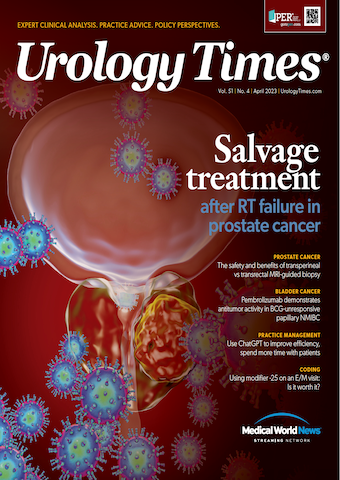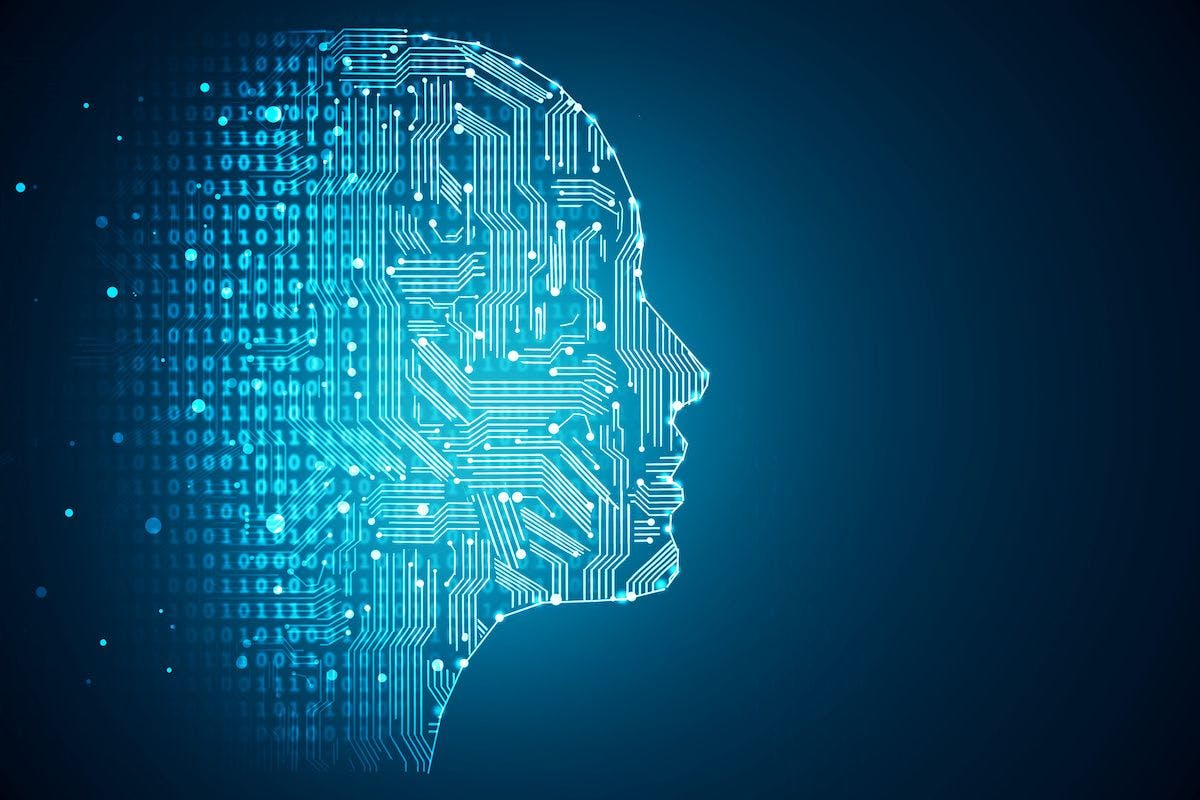Publication
Article
Urology Times Journal
How urologists can use ChatGPT to improve efficiency
Author(s):
“The more we can use AI to streamline all the less attractive aspects of our job, the better,” says David Canes, MD.
In this interview, David Canes, MD, discusses his recent Journal of Urology paper1, “Harnessing generative artificial intelligence to improve efficiency among urologists: Welcome ChatGPT.” Canes is a practicing urologist at Lahey Hospital and Medical Center in Burlington, Massachusetts.
David Canes, MD

Could you describe how AI is currently being used?
In the background of all of our lives, AI has been lurking for a long time. AI is in play when you search Google. If anyone has a Gmail account, which is most humans, you notice some suggested responses at the end of an email. So, generative AI is not new.
At the end of November 2022, ChatGPT was released. GPT stands for Generative Pre-trained Transformer. Essentially, it's a powerful neural network. Again, nothing new. What is new is suddenly it was available in a very user-friendly format, in the form of a chatbot. For the first time, any ordinary person could interface with this incredible neural network. That was only a couple of months ago, so over the past few months, most of us in medicine and surgery have at least been playing around with it to figure out how, in its current form, it might be able to help us in our day-to-day workflow.
How can ChatGPT be used in urology to help improve efficiency?
When it comes to workplace efficiency and burnout, my view—and this is shared by many—is that people start to feel burned out when they lose control over their time. And when they feel like in their day-to-day practice, they're not being the doctor that they set out to be, because maybe their workflow is a series of repetitive tasks or overrun by administrative tasks. If there's any low-stakes activity that you have to do or something repetitive, we should all be looking for a way to take that off of our plate. It looks like in its current form, and we discussed this in the article1, that right now already, ChatGPT can help with low-complexity tasks where the stakes are low.
We run through some examples [in the article]. No one should ever be staring at a blank page anymore. If you have to compose an email, you should at least get a draft in using generative AI. If you have to write a letter to an insurance company, you should start with generative AI, ChatGPT. In fact, Google just announced yesterday that they're going to be incorporating this into Google workplace, not ChatGPT, but their own neural network. Right now, throughout my day, I've got a window open that's ChatGPT, and then the other window is EHR or email or other tasks that I'm trying to accomplish. What I'm suggesting is that at some point, those are going to be integrated into all of our tools.
Let me give you a concrete example. A few weeks ago, I had a veteran who I had treated for prostate cancer. They needed a note, for a very legitimate reason, to the VA about some aspect of their benefits. So I wrote a prompt describing this. It was just 2 sentences of the type of letter I needed, and it spit out a 5-paragraph, very cogent letter that I lightly edited, and then handed to the patient. There was like a 5-minute turnaround between him sitting in my clinic asking for this letter and my turning it back to him on letterhead. Without the stress of 'Oh God, I get this unanticipated request, and now my day is derailed and it's going to take me forever,' and maybe dumping that full responsibility on my administrative assistant, it felt like a new workflow. That's just 1 example of how generative AI can be used right now.
So, email is a good one. Let's talk about that for a second. One of the nice things about ChatGPT is it remembers what it just gave you, and you can ask it to alter it. So, you can respond 'take out the part about blah blah blah' or 'change the tone; make it more friendly and upbeat.’ You do have to be careful though, because as we discussed in our article, right now, generative AI is a very clever guesser and can give wrong answers and even hallucinate. So, because ChatGPT right now is a clever guesser, you have to proofread and double check the output. That's why what we're proposing is that this is good for low-stakes communications and outputs.
For example, you could, say, write a letter to an insurance company asking for Myrbetriq [mirabegron] to be covered for overactive bladder in a patient for whom Detrol has failed, and include references to the scientific literature. It'll do that, but then the references to the scientific literature may be completely fabricated. Like, totally made up. I'm not an expert on how the large language models are constructed, but from what I understand, the neural network is very good at guessing what the very next word should be, so it's a constant statistical likelihood of what the next best word is in a string of words. It will not say 'sorry, I don't know that.’ It knows what a reference looks like and can completely make it up. Incidentally, GPT4 just came out, and I haven't used it yet, but apparently the hallucination aspect has gone down substantially, from what I hear.
Apart from emails and letters, this is really good for brainstorming. For example, you're giving a talk. You put in a prompt, 'I'm giving a talk on blah, blah, blah,' can you give me 10 proposed engaging titles for this talk and learning objectives for CME? I've done this, and the output is fantastic. I've used titles for talks that directly came out of ChatGPT. If you're facing a blank page, and you have to come up with something from scratch, this is something that that you ought to consider.
I have also used it in the context of EHR documentation. For example, I spend time in the exam room with the patient explaining—let's just use a basic example—explaining TURP [transurethral resection of the prostate] for BPH [benign prostatic hyperplasia]. That's the part of doctoring that we all really enjoy, the part where we're sitting face to-face with another human being, not the documenting of that experience. We don't like that. I've experimented with saying, 'Give me a blurb for medical record, reviewing a discussion of TURP for BPH.’ What's really interesting is now the skill becomes the prompt. In other words, composing the prompt in a way that gets you the output that you desire. For example, if you give the prompt that I just told you, sometimes you have to say 'no, have it be in the third person.’ It'll put out a letter, and you say, 'no, not a letter.’ You get good at crafting the prompt that you're looking for.
Now, Doximity has come out with, I will call it a ChatGPT wrapped up in an outer wrapping that doctors might find interesting. They have created some prompts in the background that can help you generate these types of things that I'm telling you about. I think we're going to see more of that moving forward.
Another example is answering In Basket messages from patients. Patient asks a question, you can put that into ChatGPT, without putting in HIPAA sensitive [information], you don't want to put any patient information in. [Let's] say the patient has a [urinary tract infection] and is still having irritative symptoms 1 day after starting antibiotics. You could say 'explain to a patient, at an 8th grade reading level, why having irritative voiding symptoms 24 hours after starting antibiotics for a urinary tract infection is expected.’ You'd be amazed when it comes up with. A nice, long, friendly, easy-to-understand few paragraphs that, if appropriate, you can lightly edit and copy and paste right into your EHR. If you're really looking out for your future self, you create one of those and it's so good, you turn it into a template or a dot phrase so that you can do that again the next time a patient asks a similar question.
What fascinates me about all this is that this is very early days. We're going to look back on this 5 years from now and think 'that was really cute, what we were doing.’ As it becomes baked into our software that we're already using, the tools that we're already using, I think the result, I hope, it will be lightening the load for doctors. The ultimate goal, after all, is to have as much of our time spent on actual patient care and complex decision-making. I think for most of us, we would really enjoy our jobs fully if that's predominantly how we spent our time. The more we can use AI to streamline all the less attractive aspects of our job, the better.
What advice would you give urologists who want to begin learning about these capabilities and start implementing them into their practice?
My advice to urologists is don't be intimidated by this stuff. Start simply. The web address for ChatGPT is openai.com. Interestingly, they just purchased the URL ai.com for an untold sum of money. I would say go to ai.com. You can create an account, you can use your Google account to sign in, and start messing around. Play around with this chatbot. See what it can come up with. Next time you’re about to craft an email, next time you're about to write a letter, next time you're sitting in front of a blank screen on your EHR trying to compose something, give it a shot. If it's a low-stakes task that you're embarking on, see if generative AI can help overcome writer's block for you.
Is there anything else that you’d like to add?
When I walk through the halls of the clinics where I work, and through the hospitals, one of the things that I lament the most about where medicine has gone is that I see people sitting in front of screens. It's a sad state of affairs. I don't remember things being exactly like this when I was a medical student. Urologists need to embrace generative artificial intelligence. It's not a panacea. It's 1 small tool that can chip away at the time that you spend in front of screens so that we can spend more time in front of patients, which is what we truly enjoy.
References
1. Gabrielson AT, Odisho AY, Canes D. Harnessing generative artificial intelligence to improve efficiency among urologists: Welcome ChatGPT. J Urol. Published online February 16, 2023. Accessed March 16, 2023. doi: 10.1097/JU.0000000000003383.

































